As someone who’s both an engineer and a luthier, I’m David Garcia, and the function, design, and impact of guitar bridges have been a long-time fascination of mine. If you’ve strummed a guitar once or a thousand times, the part you’ve likely overlooked is the bridge. Ever wondered how this often-forgotten component can impact your guitar’s tone and playability in such a profound way?
Come with me on a journey of discovery. From the evolution of the most familiar types of guitar bridges to investment in new, unchartered designs, there’s an intriguing narrative that unfolds through time and sound. We’ll take a deep dive into what makes the bridge the core of your guitar’s tonal signature.
This hidden gem impacts your interaction with your favourite instrument more than you realize. It’s time for the understated guitar bridge to take its spotlight. Strap in and join me to unveil the frequency-shaping secret waiting under your fingertips. We’re about to head into a world swirling with harmonics and resonance, all led by the humble guitar bridge—and its role is more pivotal than you ever imagined. So arm yourself with curiosity as we strike the first chord, setting the stage for an intriguing orchestration of knowledge yet to come.
Fundamentals of Guitar Bridges
The Role of a Guitar Bridge
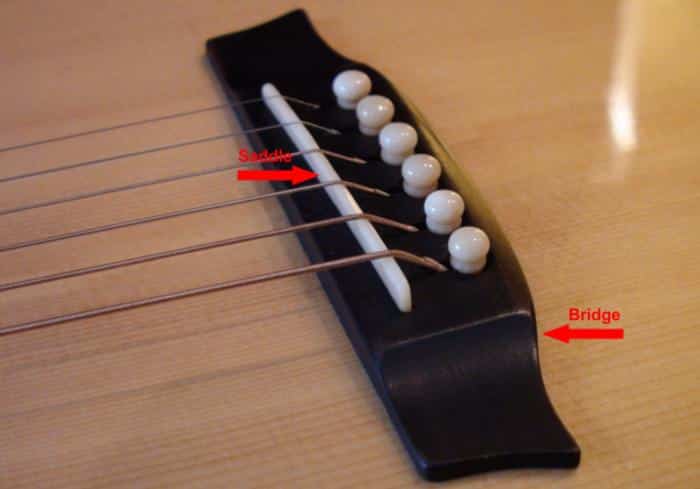
In the grand scheme of harmonics, the role of a guitar bridge may seem somewhat inconspicuous. But, as an experienced luthier, I’ve come to understand that the bridge holds incredible sway over your guitar’s sound and playability. Its contribution to the expressiveness of the instrument is far from marginal.
Beyond merely anchoring the strings to the guitar body, the bridge functions as a determinant of string sustain and intonation adjustment. It’s pivotal in controlling the tension and pitch of the strings; the accuracy of your intonation is largely reliant on the position and operational efficacy of the bridge. Leveraging this understanding can profoundly enhance your guitar’s playability. The right bridge selection can dramatically improve your instrument’s overall sound character and playability.
And that’s not all. The way a guitar bridge is constructed and the material used can profoundly influence the vibration transfer from the strings to the guitar body, affecting tone and sonic aesthetics. In this fascinating orchestration of sounds, the bridge acts as the gatekeeper, dictating the string vibrations transition into discernible music.
This understanding allows us to see the selection or modification of a guitar bridge not as a mere component replacement, but as an opportunity to enhance our instrument, bringing us closer to our desired sound and playability.
Material Impact on Tone
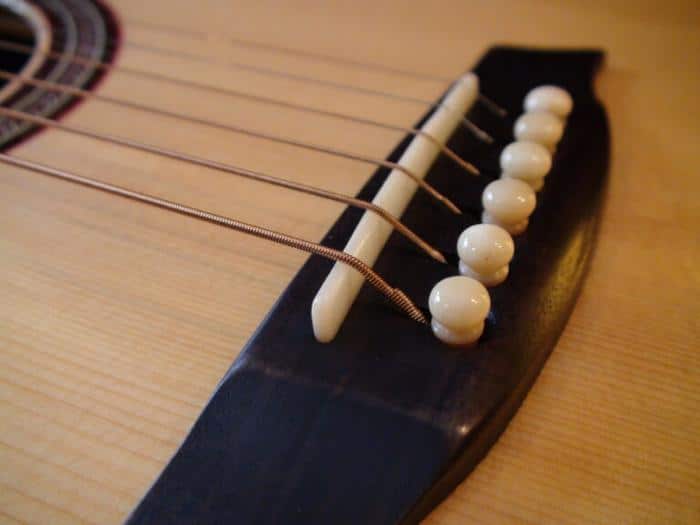
Having delved into the role of a guitar bridge, let’s consider one of the critical facets it shapes – the instrument’s tone. Pulling from years of hands-on experience with guitar crafting, I’ve come to understand that the material used in constructing the bridge plays a significant role in defining the tone.
It may not be immediately apparent, but the bridge material acts as a tone filter, absorbing specific frequencies and resonating others. In essence, the unique signature of a guitar’s sound gets coloured by the choice of bridge materials, this process significantly impacts the overall dynamics of the instrument.
The relationship between bridge types and tone is fascinatingly complex. For instance, dense, hard bridge materials such as ebony or bone tend to produce bright, clear tones. On the other hand, softer materials like rosewood or plastic lend a warmer, more subtle tonal colour to the sound.
It’s fascinating to see how these factors interplay to make each guitar a unique instrument. This subtle but essential influence on tonal characteristics adds depth to the artistry of guitar crafting. This understanding will lead us naturally into discussing the various types of guitar bridges in the next section.
Types of Guitar Bridges
Tremolo Bridges

Following our exploration of basic guitar bridge types, let’s dive deeper into the unique world of tremolo bridges. As an enthusiast who has assembled and modified several guitars featuring various tremolo systems, I can attest to their inherent power in reshaping both a guitar’s tone and playability.
A tremolo bridge, often also referred to as a ‘vibrato bridge’, transforms the guitar’s static intonation into a more dynamic one, achievable by variations in pitch introduced through the tremolo arm. The design of this arm allows for a wide range of pitch bends and vibrato effects, lending an extraordinarily expressive dimension to a guitar’s voice.
There are many variants, but the most notable ones include the floating tremolo and synchronized tremolo systems. The floating tremolo offers a wild, unrestricted vibrato, perfect for experimental genres. The more restrained, synchronized tremolo brings vintage vibes to the table, famously utilized by surf rock bands.
The tremolo bridge undoubtedly enriches the musical canvas a guitarist can play with. From subtle pitch oscillations to dramatic dive bombs, the flexibility of the tremolo bridge allows musicians to push their creativity beyond traditional boundaries. But mastering this dynamic tool requires understanding, patience, and most importantly—the joy of exploration. As we move forward, we’ll explore other types of bridges, including non-vibrato ones, providing a more rounded view of the unique characteristics and contributions each bridge type brings to a guitar’s performance dynamic.
Non-vibrato Bridges
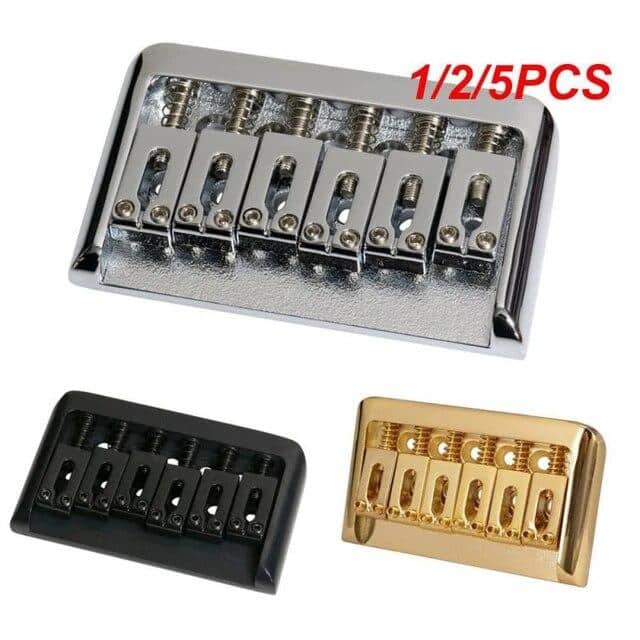
Moving on from the tremolo bridges, let’s delve into their counterpart: the non-vibrato bridges. In my personal quest for tone perfection, I’ve discovered that non-vibrato bridges, like the renowned Kahler bridge, offer a unique, crisp tone and playability. These bridges, often used in genres like punk and metal, accent the playing style by granting enhanced note articulation and clarity.
My hands-on experience with the Kahler bridge was a turning point in my understanding of its impact on tone. The non-vibrato characteristic provides a stability that enhances the resonance and sustain of each note. Its mechanical precision and reliability makes it a favorite among professionals.
Importantly, the simplicity of these non-vibrato types contributes towards ease of installation and adjustment, another excellent feature I’ve explored. Therefore, as we examine several other specific bridge types, remember how your bridge choice supports your playing style and the tone you want to achieve.
Specific Guitar Bridge Types

Delving deeper into the types of guitar bridges, I’ve noticed the distinct audio profiles strat bridges and tele bridges bring to the mix. The strat bridge, with its floating tremolo system, contributes to a smooth, wavering tone. The tele bridge, on the other hand, boasts an ashtray design that lends an unadulterated, vintage vibe. My experiences designing and modifying these specific bridges allow me to vouch for their unique resonance. They have a subtle but significant impact that validates their mention in our exploration of guitar bridge types. With each bridge, we draw closer to understanding the tones they can create.
Bridge Installation and Modification
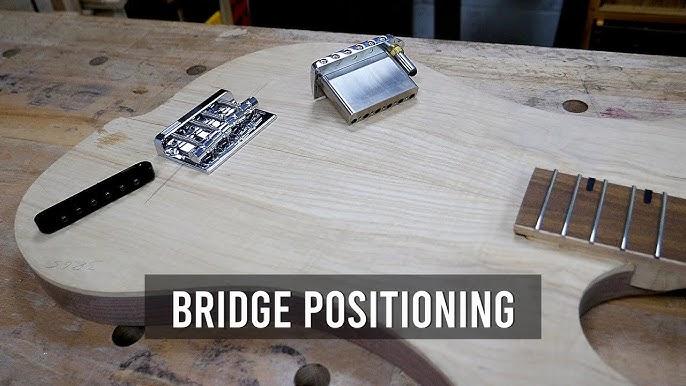
Having installed and modified a variety of bridges for different guitar styles, I can share some vital tips and techniques to guide you through the process. It’s interesting how something seemingly complex like guitar modification, particularly bridge installation, can become more manageable when you understand the logistics step by step.
Now, here’s the hook. Installing or changing a guitar bridge may seem daunting, but what if you had a step-by-step guide from an experienced engineer and a luthier? Having delved into the various types of bridges and their role in shaping the tonal characteristics of your guitar, we now step into the intriguing world of fitting and modifying these bridges, making this chapter crucial in your journey towards perfection.
Guitar modification can be quite an adventure, especially when dealing with bridge installation. I remember the first time I attempted to install a bridge, the array of tools before me seeming more intimidating than helpful. But as I understood their purpose, I realized the precision and attention to detail that goes into every process, ensuring that each contact point and string placement is just perfect.
I’ve learned how each modification can bring out a new voice from the instrument, adding a layer of complexity or simplicity depending upon the change made. From selecting the correct bridge for your guitar model to aligning it perfectly, each moment is pivotal in enhancing guitar performance.
As you start making modifications, you find yourself ready to try out different bridge styles, making your instrument not just a tool for creating music, but a piece of ever-evolving experimentation and exploration. It’s what makes this journey engaging and profound, each lesson teaching you more about the intricate language of sounds, the versatility of materials, and the perfection in engineering.
So let’s delve into this exciting journey together, shall we? Next, we’ll explore a detailed breakdown of the process, comparing and analyzing different brands and types of bridges, their pros and cons, and most importantly, how to choose and install the one best suited for your beloved guitar.
Guitar Bridge Comparison
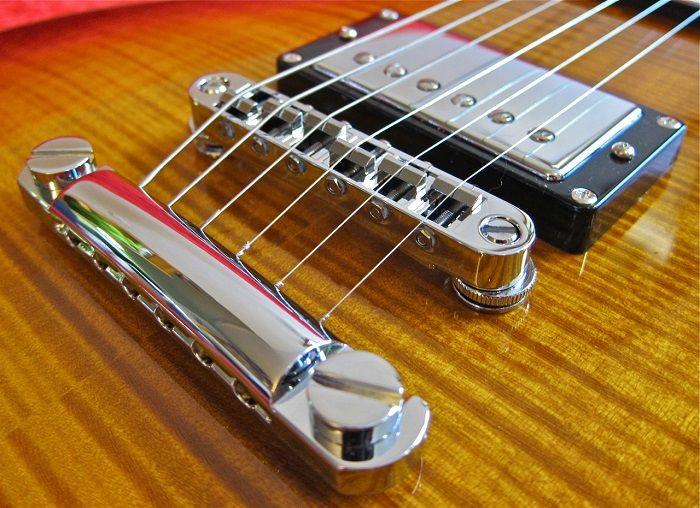
Over the course of my journey exploring guitar bridges, understanding their unique strengths, impact on intonation and action, and ability for sound customization has changed my perception of this integral guitar component significantly. Each type of bridge, whether a Floyd Rose, Tune-o-Matic or a non-vibrato bridge, comes with its own set of pros and cons and understanding this is crucial for any guitar player looking to unlock the full potential of their instrument.
What if I told you that changing your guitar bridge could be the key to unlocking your instrument’s full potential? From my own experiences, I found that various bridges had distinct impact on the overall sound quality and playability of my guitar. For instance, a Floyd Rose Tremolo bridge allowed for better control over pitch bending effects, yet had a complex design and required a steep learning curve. On the other hand, a simple non-vibrato bridge was less versatile, but offered better stability and easier maintenance.
While my personal encounters have shaped my understanding and preferences, it is crucial to remember that each individual’s playing style and tonal preferences will play a significant role in determining the most suitable bridge for them. Perhaps palm muting is a technique you frequently use, then a floating bridge might not be the best choice for you as it tends to react to the decreased string tension causing unintentional pitch alterations.
A comprehensive guitar bridge comparison, therefore, is paramount to understanding the best fit for your instrument and playing style. It’s about marrying personal preference with functionality, striking a balance between the unique abilities that different Bridges offer, and the inherent trade-offs they come with.
As we delve deeper into specific guitar bridge types, installations, modifications and address frequently asked questions, I’m eager to share more insights derived from my experiences and extensive research. So, let’s continue our exploration and give your instrument the upgrade it deserves.
FAQs
What are the different types of guitar bridges?
How do the different bridges impact the guitar’s performance?
How do I choose the right bridge for my guitar?
Conclusion
As a luthier and engineer, undoubtedly, the bridge of a guitar holds a significant place in defining its authenticity and tone. Its role, too often underestimated, is pivotal in your musical journey, anchoring the strings and transmitting vibrations to the soundboard. From tremolo bridges that offer a vibrato effect, to non-vibrato bridges for stable and robust tones, each type contributes uniquely to your guitar’s character.
Could realizing the significant role of a guitar bridge redefine your guitar playing experience? It definitely can. From the material used to the type, each aspect alters the spectrum and quality of your notes. Proper bridge installation and modification play a critical part here. Understanding how different guitar bridges compare in tone and influence can help you handpick your perfect instrument.
This article’s purpose was to walk you through the nuances of the ever-important guitar bridge. A thorough understanding of its types, modifications, and impacts will not just help you discern the difference amongst various guitars but also equip you with the knowledge to upgrade, or even build your own. Bear in mind, ‘the essence of a guitar exemplifies in its bridge’. Let this knowledge be the stepping stone to your resounding, melodious future.
